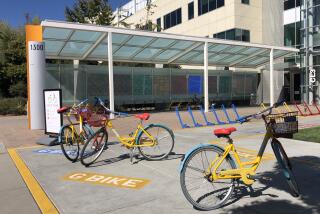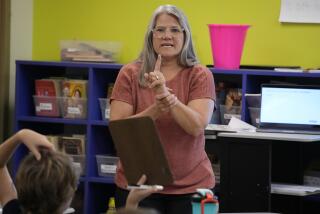Hands-On Experience in the Science Lab Vanishing From American Schools
- Share via
WASHINGTON — The most effective method ever devised for teaching science--having students do experiments in a classroom laboratory to enable them to see the results--is slowly vanishing from American schools.
The proportion of science classes that use “hands-on” activities has dropped between 15% and 27%, depending on the grade, during a recent 10-year period, according to a nationwide study done for the National Science Foundation.
The result is obvious to David Walker, a teaching assistant at the University of Maryland who supervises labs for students in introductory chemistry.
“They do not know how to use Bunsen burners, pipettes ... we would expect them to know how to use a balance, burettes to titrate, read volumes, how to light Bunsen burners,” Walker said. “You could talk to any teaching assistant and they would agree that students do not have very good lab skills.”
Students Miss Common Sense
Graduate student Dan Hatten has seen the same problems in the physics lab courses he teaches at the university. “A lot of them are not good with equipment. . . . They lack a sense of wiring simple circuits from a diagram, which is quite straightforward.” He said the students are missing the scientific common sense they should be gaining from high-school physics courses.
Walker and Hatten are witnessing firsthand the results of what a number of studies report as a dramatic decline in the amount of time high school students spend in labs. In 1977, for example, 53% of the high-school science classes surveyed included some form of laboratory exercise. When the survey was retaken in 1985-86, that share had dropped to 39%. Most science educators consider the higher figure far too low.
The cutback comes at a time of growing concern on the part of science and education groups over the poor performance of American students on standardized science tests, especially compared to students in other countries. These groups have urged schools to devote more time and money to science labs in the classroom, but their efforts often have been thwarted by a variety of factors.
In Baltimore County, for example, school officials banned a common experiment requiring students to scrape a few skin cells from inside their cheeks and study them under a microscope. Anne Arundel County in Maryland students no longer prick their fingertips to draw blood cells for similar study or for blood typing. The reason in both cases is fear--unsupported, ironically, by scientific evidence--that the experiments will spread AIDS.
Problems With Dissection
Increasing attention to the question of animal rights has brought pressure to find alternatives to laboratory dissection, with some state legislatures proposing bans on dissection.
Many school systems have given up physics and chemistry experiments that require intense heat, such as from a Bunsen burner or a hot plate, because liability insurance companies consider the risk too great. Anne Arundel County dropped a chemistry experiment using mercuric oxide several years ago because of concerns about the toxicity of mercury.
In some cases, the lack of lab work may be a byproduct of the shortage of qualified science teachers. Studies have shown that many science educators are not teaching in the field in which they specialized, making it more difficult for them to conduct a solid laboratory course.
Another force pushing schools away from science labs is the high-technology allure of computers. Although experts in teaching say some uses of computers are valuable, they note that trivial applications--far more common--are hurting science education.
Computerized Simulations
Among the worst examples, experts say, are computerized simulations of experiments that students used to do themselves.
For instance, some schools have abandoned chemistry experiments in favor of simulated experiments on a computer that displays drawings of test tubes and chemicals. Experts say such programs are little more than a cross between a video game and a textbook that turns pages at the touch of a button.
“Tutor in a box,” one National Science Foundation (NSF) official derisively calls such efforts. “This kind of thing is no substitute for a teacher or for a real lab,” said George W. Tressel, director of NSF’s division that develops materials for science education.
“It’s hard to learn science without actually touching it, doing it, seeing how the experiment really comes out,” Tressel said. “There’s a real problem with the weakening of hands-on science education.”
Law Gives Alternative
Graphics of Similarly, California students who do not want to dissect a frog in biology class, for instance, can now invoke a new state law that gives them the alternative of simulating a dissection using crude computer-generated graphics of a cut-up frog.
Critics say the exercise gives a misleading impression of what the innards of a frog are like. Aside from being depicted in false colors and crude, angular diagrams, the computer frog has no skin to cut open, no bones, no nervous system beyond the brain and spinal cord, and no circulatory system except a heart and the largest blood vessels. Only the abdomen can be “dissected,” preventing students from examining some of the frog’s most remarkable adaptations, the powerful musculature of its jumping legs and the long sticky tongue that catches insects.
Specialists in science education say lab work is valuable for several reasons. For one thing, most students remember more of what they learn by doing than of what they read in a book or hear in a lecture. Ray Hannapel, director of NSF’s research on teaching and learning, cites the old Chinese proverb: “I hear and I forget. I see and I remember. I do and I understand.”
“It’s the credo of anyone in science that doing experiments and field work is the grist of science,” Hannapel said. “You do the experiment and you remember much longer and more vividly than if you simply read about it.”
RIgorous Observation
Another value of lab work, scientists say, is that it shows students that science is fundamentally unlike any other supposed source of knowledge. It advances not on lofty pronouncements by authoritarian figures but on data-hard evidence of real events that happen in experiments or under rigorous observation of the natural world.
One value of such findings is that they often fly in the face of widespread assumptions.
“What modern science is about,” said Carl Sagan, the Cornell University planetary scientist, “is a succession of counter-intuitive discoveries. It’s confronting nature as it is, even if it contradicts your expectations about how things work.”
The concerns were heightened by a recent national survey on science achievement among third, seventh and 11th graders, in which fewer than half of seventh-grade science teachers said they had access to a general-purpose laboratory. Among students, half of the seventh graders said they never worked on experiments alone and a third said they never got to do experiments even in groups.
Teachers, Books Dominate
“While . . . many science educators encourage the use of hands-on activities, responses from students in all three grades indicate that science instruction continues to be dominated by teacher lectures and textbooks,” the report by the National Assessment of Educational Progress said.
Perhaps the most powerful force in the changing nature of the science classroom is technology-curriculum packaged on videodiscs, interactive video that combines computer technology and video, and computers that become scientific instruments when they are attached to thermometers and other sensors.
Such sophisticated technology is already available in many classrooms. Baltimore County students, for example, use computer simulations in combination with lab work to study diffusion.
“It’s not replacing hands-on lab experiences,” said Anita Stockton, the county’s science coordinator. But the movement of molecules in the computer simulation, she said, “is done with more finesse and depth than a teacher can do with chalk on a chalkboard.”
Analytic Instrument
One of the best uses of computers in the classroom, experts say, turns a computer into an analytic instrument. The readings from an electronic thermometer, for instance, show up on the computer screen as a graph of temperatures that change over time.
There are also computer simulations that provide altogether new experiences, allowing students to operate a nuclear plant, move Earth’s geologic plates, or heat and cool chemical solutions to temperatures impossible in an ordinary lab.
While many educators are calling for a balance, there is plenty of disagreement about how much of the new technology should be embraced.
“The only reason we do (real) frogs is because they’re cheap,” said James A. Mecklenberger, director of the National School Boards Assn.’s Institute for the Transfer of Technology to Education. “Why shouldn’t we dissect a horse or an elephant or a giraffe” on a computer screen?
Mistaken Notions Feared
Mecklenberger argues that it is time to redesign the science curriculum around the rapidly developing technology. “You get to a place where you’ve got simulations that are so good that you wonder why you would ever do it for real,” he said.
But other scientists contend that computers may give students mistaken notions about the scientific process.
“Students get the idea that whatever is on the computer is correct,” said Thomas Custer, science coordinator for Anne Arundel County schools. In a real laboratory situation, he said, experimental results often differ, and students must learn how to deal with differing results.
Juliana Texley, a teacher and editor of “Science Teacher” magazine, agreed: “I’m afraid it could become sterile, book and computers, where there’s never anything alive in the classroom.”
More to Read
Sign up for Essential California
The most important California stories and recommendations in your inbox every morning.
You may occasionally receive promotional content from the Los Angeles Times.













